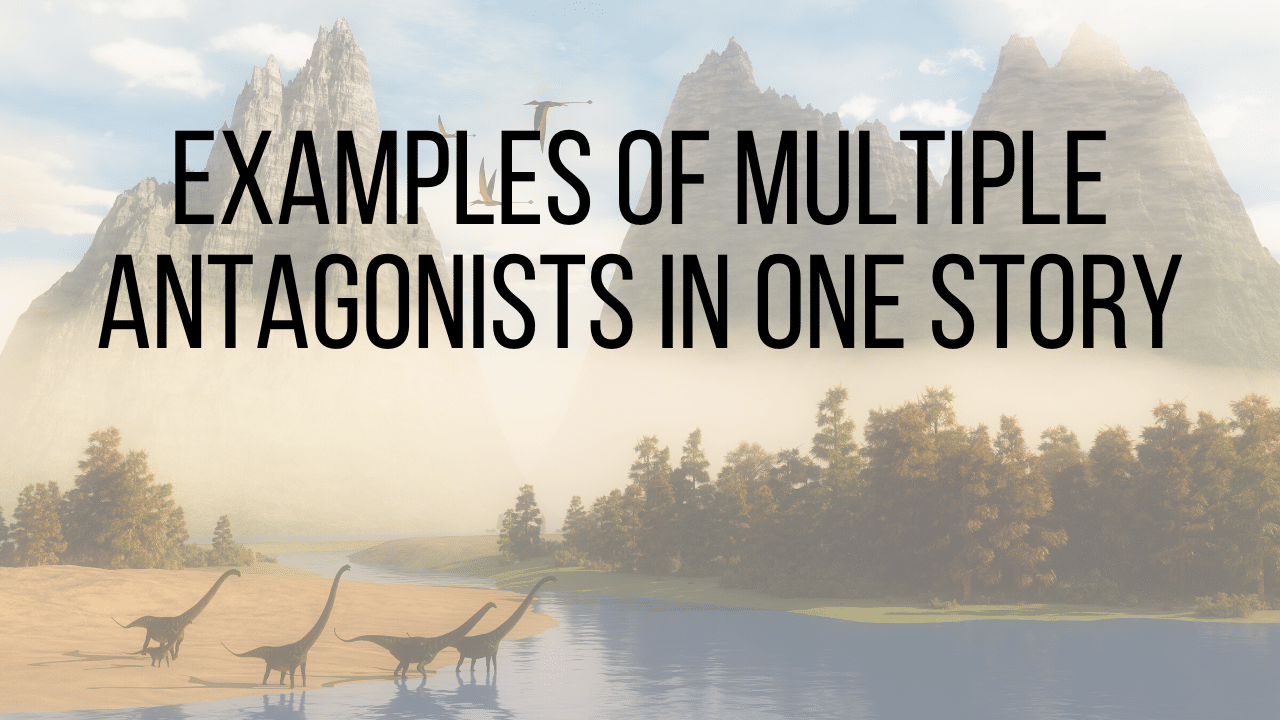As an Amazon Associate I earn from qualifying purchases.
Written by JJ Barnes
Just as multiple protagonist stories can be highly entertaining, stories with multiple antagonists can work really well. However, you can write a multiple antagonist story with just one protagonist. Each antagonist is set against the protagonist in a different way, each working against what your protagonist wants.
I’ll be referencing the film Jurassic Park. During the course of the picture, there are multiple Antagonists all disrupting the experiences of the Protagonists, Grant, Ellie, and (essentially) the entirety of the human race. I’ll explain what they do in the story, and how you can replicate that style in your own work.

Multiple Antagonists In Jurassic Park
The obvious antagonist in Jurassic Park is John Hammond. He was the designer of Jurassic Park and, arguably, is responsible for all the things that went wrong.
There’s also Dennis Nedry who sells the science to a rival company, then shuts down the electricity when stealing the “dino DNA”, which then frees the dinosaurs from their cages.
The dinosaurs themselves are also Antagonists, because they want to be free, and the humans don’t want them to be free.
John Hammond
John Hammond is the “man playing God,” which is a kind of antagonist which features frequently in stories, particularly in science fiction. Humans deciding that they are able to create and control life usually ends badly in story, as it sets the created life against the existing life.
A lot of science fiction, at its core, is about the consequences of choosing to create sentient beings, be they living creatures or robots. The story follows the course of the human beings trying to exist, and the created life forces trying to become dominant. As their enabler, John Hammond represents the created life in this conflict.
Dennis Nedry
Dennis Nedry is representative of “the criminal.” Criminals are frequently occurring Antagonists. They are morally unscrupulous characters, and their downfall is their greed. The criminal who is willing to put everyone at risk for their own personal gain is a great character to deploy in your story.
In the case of Nedry, he’s there from the beginning being sneaky, and even though nobody likes him he’s still trusted enough to have access to everything he needs to be the criminal. So, to use a character like this in your own story, it needs to be somebody who is motivated to put everything at risk, but also trusted enough to be able to do it. This is the character that will often be revealed as the betrayer in a plot twist moment.
Thematically Nedry is particularly interesting because he represents the lack of control John Hammond has over life. Hammond thinks he has control over everybody which is why Nedry is able to do the things he does. Hammond is arrogant enough to not consider the possibility of betrayal.
Nature
Nature itself makes an excellent antagonist in stories. As Jeff Goldblum’s character Dr. Ian Malcolm says, life will find a way.
Nature is intent on surviving and flourishing, even when humans think they are able to stop it. In Jurassic Park, that is demonstrated by the discovery that the dinosaurs can change their sex because of the frog DNA used in their creation. It hammers home the price of your character playing God.
Nature will not be controlled. Dinosaurs being able to change sex means they’re able to breed, so they can appear in unexpected places and in larger numbers. This sometimes appears in stories as a volcano, a hurricane, or a tidal wave. But it’s always nature set to do what nature does, and humans being unable to stop it.
Multiple Antagonists vs Protagonists
Essentially, all your different Antagonists are working to do something which, when combined, cause a massive problem for your Protagonist. Individually, each antagonist makes things a challenge, but when combined your protagonist is outmatched and forced to grow and change.
In Jurassic Park, even though killing everybody isn’t the goal of the Antagonists, the consequences of what they’re all doing has that result.
Creating Multiple Antagonists
When you have multiple Antagonists, you’ll find that a number of them won’t be evil, they’re not a villain or a bad guy, they’re just flawed humans who are unable to keep their flaws in check.
In the case of John Hammond, his flaw is his arrogance. He isn’t a “bad guy” who wants to hurt people, he just lacks self-awareness and that causes him to accidentally hurt people. Personally, I really enjoy an Antagonist who is ultimately a good person but just makes huge mistakes and doesn’t fix them. What you need to remember is that when you’re creating an Antagonist, their role in your story is to be Antagonistic towards your Protagonist. So, any kind of Antagonist you put into your story, they’re only an Antagonist if their goals are actively set against the goals of your Protagonist.
More From JJ Barnes:
I am an author, filmmaker, artist and youtuber, and I am the creator and editor of The Table Read.
You can find links to all my work and social media on my website: www.jjbarnes.co.uk
Buy my books: www.sirenstories.co.uk/books
Follow me on Twitter: @JudieannRose
We strive to keep The Table Read free for both our readers and our contributors. If you have enjoyed our work, please consider donating to help keep The Table Read going!
Amazon and the Amazon logo are trademarks of Amazon.com, Inc, or its affiliates.


